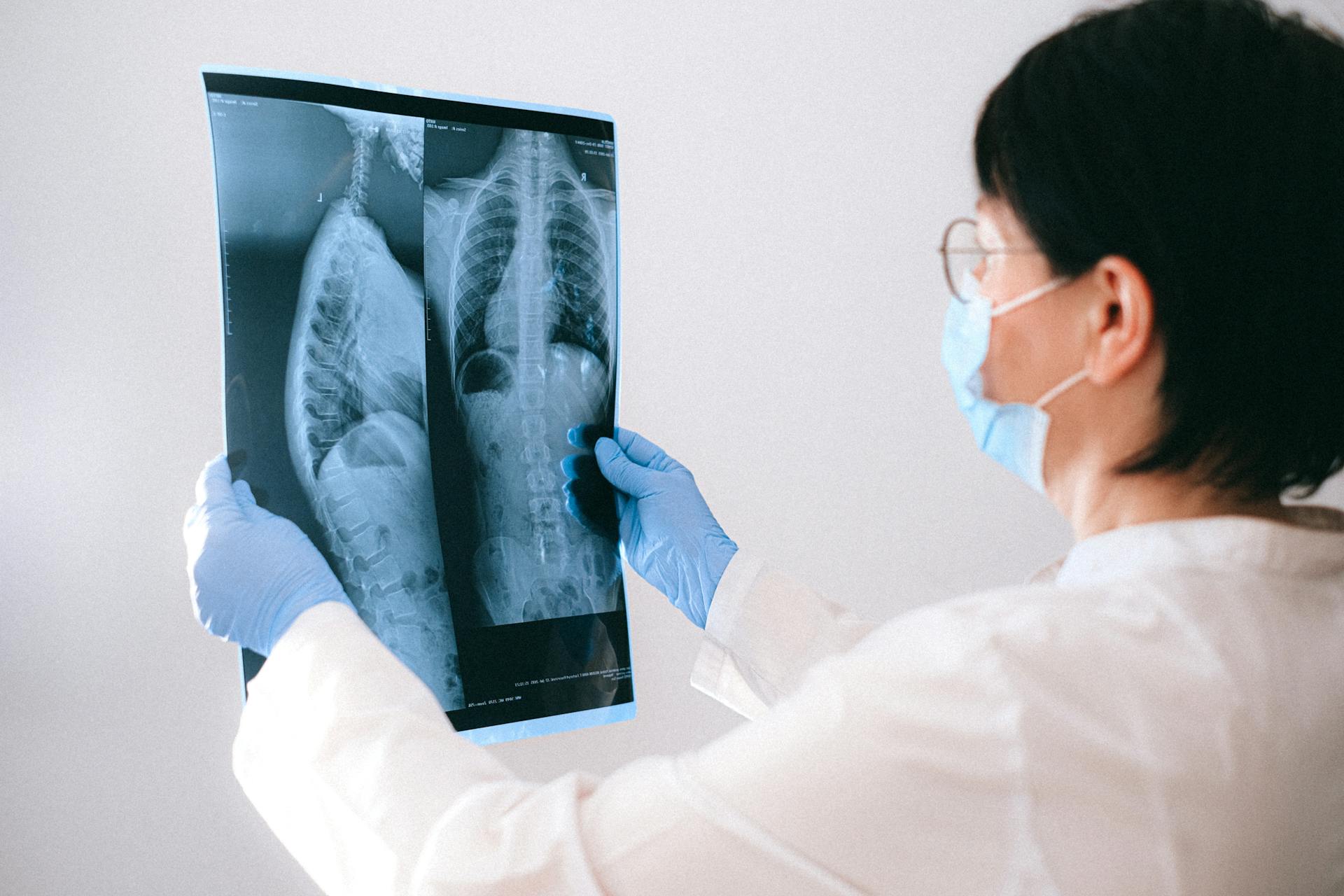
Diagnosing canine lung cancer can be a challenging process, often requiring a combination of physical examination, imaging tests, and biopsy results.
The most common symptoms of lung cancer in dogs include coughing, difficulty breathing, and weight loss.
A veterinarian may use a stethoscope to listen for abnormal lung sounds, such as wheezing or crackling.
Chest X-rays are commonly used to visualize the lungs and detect any abnormalities.
Lung cancer in dogs is often diagnosed at an advanced stage, which can make treatment more difficult.
The prognosis for dogs with lung cancer varies depending on the stage and type of cancer.
Causes and Risk Factors
Canine lung cancer is a complex and multifaceted disease. Carcinomas are the most common primary tumors in dogs.
While the exact causes of canine lung cancer are still being researched, we do know that environmental factors such as exposure to cigarette smoke and air pollution may play a role. However, a clear relation between these factors and lung cancer in dogs has not been proven.
Metastatic disease is actually more common than primary tumors in dogs, which can make diagnosis and treatment more challenging.
Curious to learn more? Check out: Canine Brain Tumors
Age Predisposition

Age predisposition is a significant factor in certain types of cancer in animals.
As we age, our risk of developing certain types of cancer increases. In fact, older animals are more likely to develop pulmonary carcinoma, a type of lung cancer, typically after the age of 10.
Some breeds, such as Boxers and Irish Setters, may be more prone to pulmonary carcinoma, but it's worth noting that breed predisposition is not always clear-cut.
The age at which metastatic disease occurs depends on the incidence of the primary tumor.
Here's a breakdown of the age predisposition for certain types of cancer:
- Pulmonary carcinoma: typically affects animals over 10 years old
- Metastatic disease: age depends on the incidence of the primary tumor
Pathogenesis
Carcinomas are the most common primary tumors, but interestingly, a clear relation with environmental factors like cigarette smoke and air pollution has not been proven.
Sarcomas are rare as primary diseases, which means they don't occur as often as other types of tumors.
Metastatic disease is actually more common than primary tumors, which can be a bit scary to think about.
Here are some key facts about primary and metastatic tumors:
- Carcinomas are the most common primary tumors.
- Sarcomas are rare as primary diseases.
- Metastatic disease is more common than primary tumors.
Symptoms and Diagnosis
Symptoms of canine lung cancer can be challenging to detect, but there are some common signs to look out for. Coughing, lethargy, rapid breathing, and vomiting are all possible symptoms, depending on the size and location of the tumor.
A large percentage of dogs show no signs of lung cancer, so tumors are often detected during unrelated diagnostic testing, such as an X-ray. If you've noticed any of these symptoms in your dog, it's essential to contact a veterinary oncology team for an examination.
The primary way vets confirm a lung cancer diagnosis in dogs is through a chest x-ray. If the X-ray shows signs of a lung tumor, further testing such as an ultrasound-guided aspiration or biopsy, abdominal ultrasound, or CT scan may be necessary to determine the extent of the cancer.
Common symptoms of canine lung cancer include:
- Cough
- Dyspnea/tachypnea
- Weight loss - common
- Other signs of neoplasia
- Hemoptysis
Signs & Symptoms
Cancer in dogs can be a challenging condition to detect, but there are some common signs and symptoms to look out for. Early detection is key to positive treatment outcomes.

Sores that don't heal, bleeding or discharge, and strong odor are all potential signs of cancer in dogs. If you notice any of these symptoms, make an appointment with your vet as soon as possible.
Loss of appetite, unexplained weight loss, and swelling are also common signs of cancer in dogs. These symptoms can be subtle, but they can be indicative of a more serious underlying condition.
Some cancer symptoms in dogs are similar to those in people, such as lumps or bumps beneath the skin, lethargy, and difficult or painful breathing. These symptoms can be found during an exam or at home.
A lump or bump found during an exam or at home is one of the most common symptoms of cancer in dogs. It could be an enlarged lymph node, limping, or pain.
Weight loss, fatigue, and decreased appetite are also common symptoms of cancer in dogs. These symptoms can be mistaken for normal aging, but they can be indicative of a more serious underlying condition.
Here are some common signs and symptoms of cancer in dogs:
- Sores that don't heal
- Bleeding or discharge
- Loss of appetite
- Unexplained weight loss
- Strong odor
- Swelling
- Lumps or bumps beneath the skin
- Lethargy, depression, disinterest in exercise
- Difficult or painful breathing or coughing
- Straining when going to the bathroom
- Challenges when eating or swallowing
- Pain or difficulty walking, lameness or stiffness
- Coughing
- Lethargy
- Rapid breathing/wheezing
- Vomiting
How Dogs Are Diagnosed
Cancer in dogs can be diagnosed in several ways, including a fine needle aspirate or biopsy, which are often used to get a sample of the affected area.
Imaging tests like MRI can be very helpful, especially when the tumor is located in a hard-to-reach place like the brain.
Blood tests, such as the Cadet test, are also being used to detect certain types of cancer, like blood or bladder cancer.
The Nu.Q Veterinary Cancer Screening Test and the OncoK9 test can help determine if cancer is likely, but they don't specify the type of cancer.
If your dog is showing signs of lung cancer, it's essential to get them checked by a vet as soon as possible.
A chest x-ray is usually the first step in confirming a diagnosis of lung cancer in dogs, and if the x-ray shows a lung tumor, further testing like an ultrasound-guided aspiration or biopsy may be needed.
Further testing, such as an abdominal ultrasound or CT scan, can help determine the extent of the cancer in your dog's body.
Curious to learn more? Check out: Canine Brucellosis Test
About
I'm here to help you understand the basics of a condition that affects millions of people worldwide. It's a complex topic, but don't worry, I'll break it down in a way that's easy to grasp.

This condition is often referred to as a chronic illness, which means it's long-lasting and can't be cured. However, with proper treatment and management, people can lead active and fulfilling lives.
The symptoms of this condition can vary from person to person, but common ones include persistent fatigue, muscle pain, and joint pain. In some cases, people may also experience headaches, brain fog, and mood changes.
The exact cause of this condition is still unknown, but research suggests that a combination of genetic, environmental, and lifestyle factors may contribute to its development. This means that there's no single trigger or cause, but rather a complex interplay of factors.
Symptoms can be triggered by various factors, including stress, lack of sleep, and certain medications. Understanding what triggers your symptoms can help you develop a personalized plan to manage them.
If this caught your attention, see: Canine Cancer Pain Management
Treatment and Cost
The average cost to treat a dog with cancer can vary greatly, ranging from a few hundred dollars for less complicated cases to $15,000 or more for more complex situations.
It's also worth noting that costs can differ depending on where you live, with some areas being more expensive than others.
Meeting with a veterinary oncologist can be a good idea, as they can help create a treatment plan and discuss lower-cost options for your dog's specific cancer.
Chemotherapy treatments can be several thousands of dollars, but surgery to remove the lung tumor is often successful and relatively affordable, with many dogs tolerating it well and returning home soon after.
Dogs with Treatments
Decades ago, veterinarians used generic and off-label human cancer treatments for dogs, but now there are FDA-approved cancer drugs available specifically for dogs.
In 2009, the first FDA-approved cancer drug for dogs became available, marking a significant shift in treatment options.
Working with a veterinary oncologist is crucial to understand the best treatment plan for your dog's cancer, as they can help you navigate the complexities of treatment.
Treating cancer doesn't always make it better, and sometimes it can even make things worse, so it's essential to have a team of experts working together to develop an integrated plan.
Surgery can be a successful treatment option for dogs with lung cancer, especially if the tumor is localized and can be removed.
Chemotherapy and/or radiation may be recommended if the tumor cannot be surgically removed or if the cancer has spread.
A fresh viewpoint: Mast Cell Tumor in Pit Bulls
Average Cost to Treat a Dog
The average cost to treat a dog with cancer can vary greatly depending on the type of cancer and the location.
Some cancers can be treated for a few hundred dollars, but more complicated cases can cost $15,000 or more.
It also depends on where you live, as some areas are more expensive than others.
Many chemotherapy treatments can be several thousands of dollars, but there are often lower-cost options available.
Meeting with a veterinary oncologist can be a good first step, as they can discuss a treatment plan and standard treatment options for your dog's cancer for a few hundred dollars.
Frequently Asked Questions
What are the final stages of lung cancer in dogs?
The final stages of lung cancer in dogs are characterized by decreased appetite, weight loss, and labored breathing due to fluid buildup in the lungs. If you notice these symptoms, seek immediate veterinary attention to ensure your dog's comfort and quality of life.
How do you comfort a dog with lung cancer?
To comfort a dog with lung cancer, your veterinarian may prescribe medications to reduce inflammation, alleviate coughing, and open airways, making your dog more comfortable. Medications such as anti-inflammatory pain relievers, cough suppressants, and bronchodilators can help improve your dog's quality of life.
What is the best treatment for dogs with lung cancer?
Unfortunately, there is no "best" treatment for dogs with lung cancer, as it depends on various factors such as the dog's overall health, cancer stage, and individual needs. However, veterinarians may recommend radiation therapy options like stereotactic radiation therapy (SRT) for some cases.
Where does lung cancer in dogs metastasize?
Lung cancer in dogs can metastasize to various organs, including the lungs, lymph nodes, pleura, bones, and brain. Understanding the metastatic potential of canine lung cancer is crucial for effective treatment and management.
How quickly does lung cancer progress in dogs?
Lung cancer in dogs typically progresses rapidly, with a life expectancy of approximately two months if the disease has spread to the thoracic lymph nodes. However, with treatment like stereotactic radiation, progression can be slowed in some cases.
Sources
- https://www.vetlexicon.com/canis/oncology/articles/lung-pulmonary-neoplasia/
- https://www.merckvetmanual.com/dog-owners/lung-and-airway-disorders-of-dogs/cancers-and-tumors-of-the-lung-and-airway-in-dogs
- https://www.springhouseanimalhospital.com/site/blog/2021/11/18/tumors-in-dogs
- https://www.webmd.com/pets/dogs/features/dogs-and-cancer-get-the-facts
- https://www.pacificsantacruzvet.com/site/blog/2024/01/15/dog-lung-cancer
Featured Images: pexels.com


